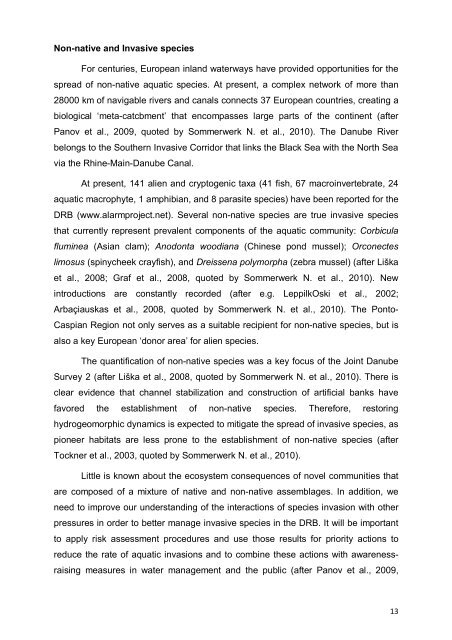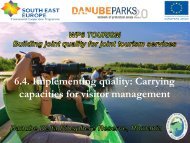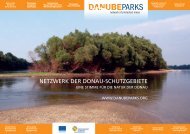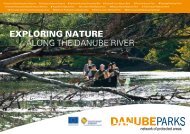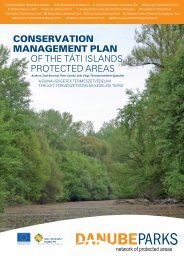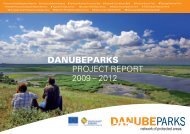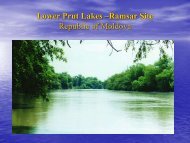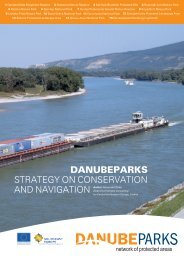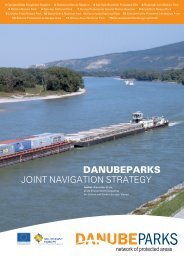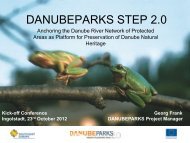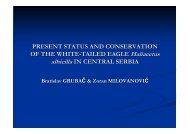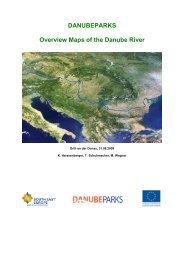Danube Rivers Morphology and Revitalization - DANUBEPARKS
Danube Rivers Morphology and Revitalization - DANUBEPARKS
Danube Rivers Morphology and Revitalization - DANUBEPARKS
You also want an ePaper? Increase the reach of your titles
YUMPU automatically turns print PDFs into web optimized ePapers that Google loves.
Non-native <strong>and</strong> Invasive speciesFor centuries, European inl<strong>and</strong> waterways have provided opportunities for thespread of non-native aquatic species. At present, a complex network of more than28000 km of navigable rivers <strong>and</strong> canals connects 37 European countries, creating abiological ‘meta-catcbment’ that encompasses large parts of the continent (afterPanov et al., 2009, quoted by Sommerwerk N. et al., 2010). The <strong>Danube</strong> Riverbelongs to the Southern Invasive Corridor that links the Black Sea with the North Seavia the Rhine-Main-<strong>Danube</strong> Canal.At present, 141 alien <strong>and</strong> cryptogenic taxa (41 fish, 67 macroinvertebrate, 24aquatic macrophyte, 1 amphibian, <strong>and</strong> 8 parasite species) have been reported for theDRB (www.alarmproject.net). Several non-native species are true invasive speciesthat currently represent prevalent components of the aquatic community: Corbiculafluminea (Asian clam); Anodonta woodiana (Chinese pond mussel); Orconecteslimosus (spinycheek crayfish), <strong>and</strong> Dreissena polymorpha (zebra mussel) (after Liškaet al., 2008; Graf et al., 2008, quoted by Sommerwerk N. et al., 2010). Newintroductions are constantly recorded (after e.g. LeppilkOski et al., 2002;Arbaçiauskas et al., 2008, quoted by Sommerwerk N. et al., 2010). The Ponto-Caspian Region not only serves as a suitable recipient for non-native species, but isalso a key European ‘donor area’ for alien species.The quantification of non-native species was a key focus of the Joint <strong>Danube</strong>Survey 2 (after Liška et al., 2008, quoted by Sommerwerk N. et al., 2010). There isclear evidence that channel stabilization <strong>and</strong> construction of artificial banks havefavored the establishment of non-native species. Therefore, restoringhydrogeomorphic dynamics is expected to mitigate the spread of invasive species, aspioneer habitats are less prone to the establishment of non-native species (afterTockner et al., 2003, quoted by Sommerwerk N. et al., 2010).Little is known about the ecosystem consequences of novel communities thatare composed of a mixture of native <strong>and</strong> non-native assemblages. In addition, weneed to improve our underst<strong>and</strong>ing of the interactions of species invasion with otherpressures in order to better manage invasive species in the DRB. It will be importantto apply risk assessment procedures <strong>and</strong> use those results for priority actions toreduce the rate of aquatic invasions <strong>and</strong> to combine these actions with awarenessraisingmeasures in water management <strong>and</strong> the public (after Panov et al., 2009,13


